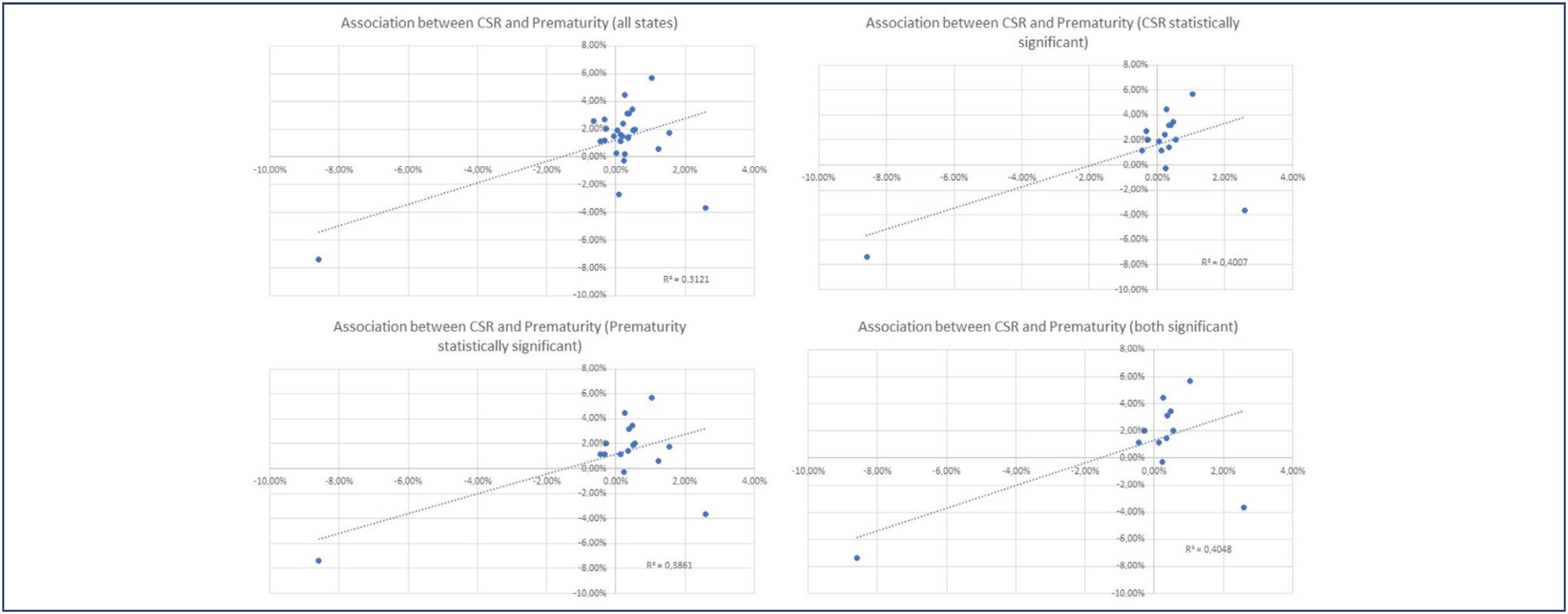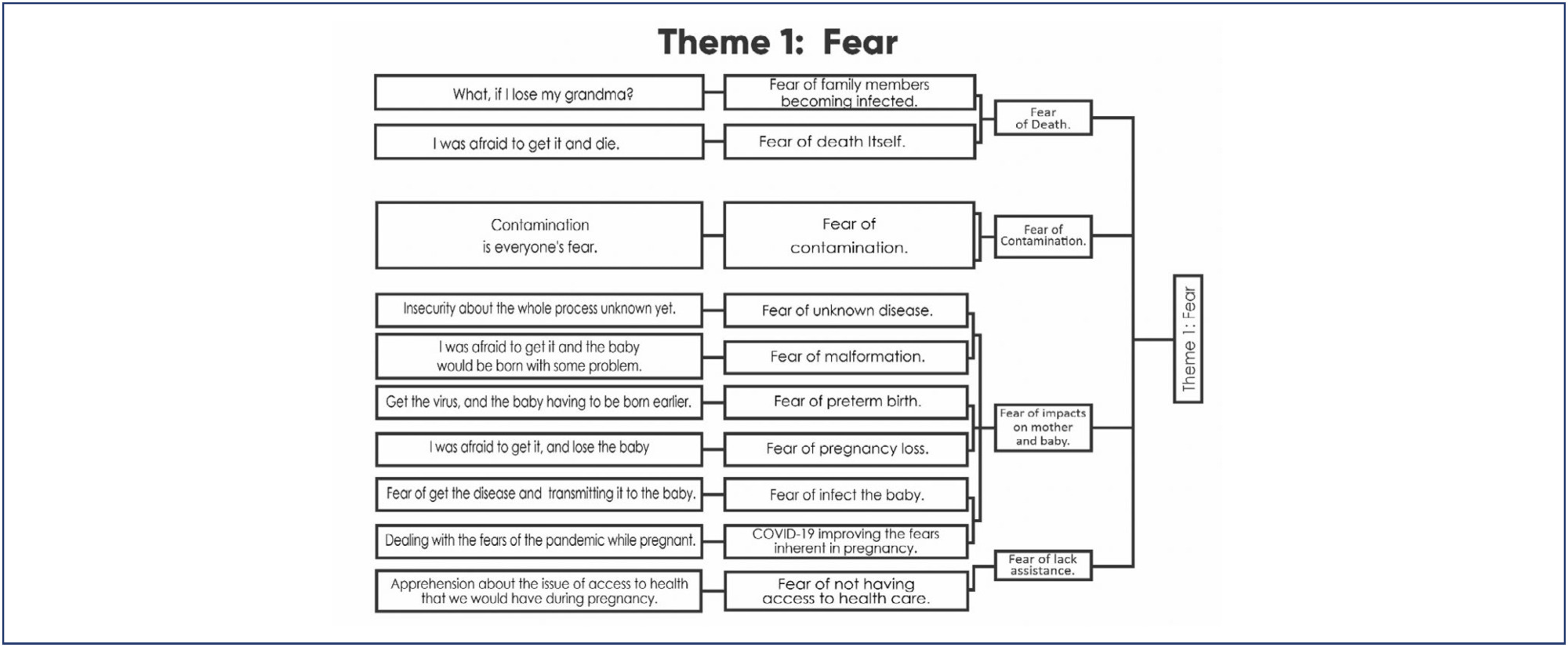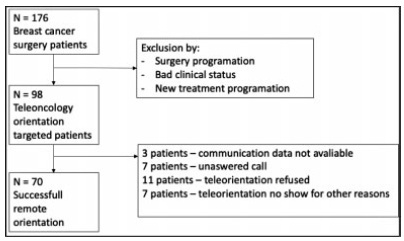-
Original Article
Effect of COVID-19 on Brazilian cesarean and prematurity rates: a cross-sectional study
Revista Brasileira de Ginecologia e Obstetrícia. 2025;47:e-rbgo6
03-18-2025
Summary
Original ArticleEffect of COVID-19 on Brazilian cesarean and prematurity rates: a cross-sectional study
Revista Brasileira de Ginecologia e Obstetrícia. 2025;47:e-rbgo6
03-18-2025Views84See moreAbstract
Objective:
To investigate the relationship between prematurity and cesarean section rate in Brazil during the beginning of COVID-19 pandemic.
Methods:
Utilizing the Robson Classification, this study analyzed data from the Brazilian Ministry of Health's Live Births Panel, comparing CSR) and group 10 (preterm deliveries) between 2019 (pre-pandemic) and 2021 (pandemic) in each of Brazilian states and the overall country. The prematurity and CSR were compared using prevalence ratio and confidence interval, and p-value was obtained. The variation of prematurity and CSR were compared through the coefficient of determination (R2).
Results:
A total of 5,522,910 deliveries were evaluated during the period. The CSR increased from 56.34% to 57.05% (p<0.01), and the frequency of preterm deliveries rose from 8.99% to 9.13% (p<0.01). The CSR increased in 23 States and decreased in 4 States, while the prematurity rate increased in 16 States and decreased in 10 States. A positive relationship between the increase of CSR and prematurity was observed during COVID-19, with an R2 value of 0.3121, suggesting a moderate association between these two variables.
Conclusion:
Between 2019 (pre-COVID-19 pandemic) and 2021 (the first full year of the COVID-19 pandemic), there was an increase in prematurity and CSR in Brazil. These increases were observed in most Brazilian states and may be correlated. However, it is impossible to establish a cause-effect relationship given the design of this study.

-
Original Article
The experience of pregnancy in the COVID-19 pandemic
Revista Brasileira de Ginecologia e Obstetrícia. 2025;47:e-rbgo8
03-18-2025
Summary
Original ArticleThe experience of pregnancy in the COVID-19 pandemic
Revista Brasileira de Ginecologia e Obstetrícia. 2025;47:e-rbgo8
03-18-2025Views88See moreAbstract
Objective:
To describe women's experience of pregnancy during the COVID-19 pandemic.
Methods:
A qualitative study conducted in a private maternity hospital, from May, 2020 to November, 2021, with women aged ≥ 18 years, gestational age ≥ 36 weeks at birth and ≥ 24 hours post-partum. Data collected through semi-structured interviews, recorded, transcribed, and analyzed adopting Krippendorff's Content Analysis as theoretical-methodological framework.
Results:
Four main themes emerged: Fear, Taking care and celebrating pregnancy: adjusting to the new reality, Harms of Isolation, and Benefits of Isolation. The fear of contamination and its impact on the health of mother and child resulted in the adoption of severe social isolation, including from those considered sources of support by the expecting mother. Overwhelmed, some of the participants reported loneliness and psychic suffering. The opportunity to focus on the pregnancy, the preparations for the arrival of the child, and the family made isolation a beneficial and positive period for other women.
Conclusion:
The experience of pregnancy in the Pandemic was an event outside of the ordinary and common. The expecting mother faced her worst fears on a daily basis and attended prenatal care, in order to ensure her child would be born healthy. The celebration of the baby's life, amid so many deaths, had to be adjusted to the virtual environment. It was a tense, solitary, and ambiguous period, which demanded a lot from the mental health of some participants, but to others, brought advantages that would not have been possible in different times.

-
Original Article
Access and adequacy of antenatal care in a city in Brazil during two phases of the COVID-19 pandemic
Revista Brasileira de Ginecologia e Obstetrícia. 2024;46:e-rbgo87
10-23-2024
Summary
Original ArticleAccess and adequacy of antenatal care in a city in Brazil during two phases of the COVID-19 pandemic
Revista Brasileira de Ginecologia e Obstetrícia. 2024;46:e-rbgo87
10-23-2024Views151Abstract
Objective:
To compare access and suitability of antenatal care between years 2020 and 2022 among postpartum individuals at a Hospital in Florianopolis, and evaluate factors associated with antenatal suitability.
Methods:
Observational, cross-sectional, and quantitative study carried out in 2022. Collected data were compared with the database of a previous similar study carried out in the same setting in 2020. Data were extracted from medical records and prenatal booklets, in addition to a face-to-face questionnaire. Adequacy was measured using the Carvalho and Novaes index and health access was qualitatively evaluated. Socio-demographic and antenatal variables were analyzed. A statistical significance level of 0.05 was considered. Open-ended questions were categorized for analysis.
Results:
395 postpartum individuals were included. Antenatal care was adequate for 48.6% in 2020 and 69.1% in 2022. Among the barriers to access, 56% reported difficulty in scheduling appointments and/or exams and 23% complained of reduced healthcare staff due to strikes, COVID-19, among others. Adequate antenatal care was associated with being pregnant in 2022, being referred to high-risk units (PNAR), and not reporting difficulties in access. Also, it was associated with twice the chance of investigation for gestational diabetes (GDM) and syphilis.
Conclusion:
The 2022 post-vaccination period showed higher antenatal adequacy. The main difficulty for postpartum individuals was scheduling appointments and/or exams. Having antenatal care in 2022, no reports of difficulty in access, and follow-up at a high-risk unit were associated with antenatal adequacy.
Key-words COVID-19Delivery of health careDiabetesGestationalpandemicsPostpartum periodPregnancyPrenatal caresurveys and questionnairesVaccinationSee more -
Original Article
Tubal ectopic pregnancy: comparative management between pre and Covid-19 pandemic periods
Revista Brasileira de Ginecologia e Obstetrícia. 2024;46:e-rbgo64
06-03-2024
Summary
Original ArticleTubal ectopic pregnancy: comparative management between pre and Covid-19 pandemic periods
Revista Brasileira de Ginecologia e Obstetrícia. 2024;46:e-rbgo64
06-03-2024Views120See moreAbstract
Objective:
To evaluate whether there were differences in the presentation of patients with tubal ectopic pregnancy (EP) during the first year of the COVID-19 pandemic.
Methods:
We performed a retrospective cohort study of all cases of tubal EP between March 2019 and March 2020 (pre-pandemic) and between March 2020 and March 2021 (pandemic). We compared between these two groups the risk factors, clinical characteristics, laboratory data, sonographic aspects, treatment applied and complications.
Results:
We had 150 EP diagnoses during the two years studied, of which 135 were tubal EP. Of these, 65 were included in the pre-pandemic and 70 in the pandemic period. The prevalence of lower abdominal pain was significantly higher in the pandemic compared to the pre-pandemic period (91.4% vs. 78.1%, p=0.031). There was no significant difference in shock index, initial beta-hCG level, hemoglobin level at diagnosis, days of menstrual delay, aspect of the adnexal mass, amount of free fluid on ultrasound, and intact or ruptured presentation between the groups. Expectant management was significantly higher during the pandemic period (40.0% vs. 18.5%, p=0.008), surgical management was lower during the pandemic period (47.1% vs. 67.7%, p=0.023), and number of days hospitalized was lower in the pandemic period (1.3 vs. 2.0 days, p=0.003).
Conclusion:
We did not observe a significant difference in patient history, laboratory and ultrasound characteristics. Abdominal pain was more common during the pandemic period. Regarding treatment, we observed a significant increase in expectant and a decrease in surgical cases during the pandemic period.
-
Original Article
Prevalence and factors associated with anxiety, depression and burnout in gynecology and obstetrics residents during the COVID-19 pandemic
Revista Brasileira de Ginecologia e Obstetrícia. 2024;46:e-rbgo17
00-00-2024
Summary
Original ArticlePrevalence and factors associated with anxiety, depression and burnout in gynecology and obstetrics residents during the COVID-19 pandemic
Revista Brasileira de Ginecologia e Obstetrícia. 2024;46:e-rbgo17
00-00-2024Views423Abstract
Objective:
To determine the prevalence of anxiety, depression and burnout in residents of Gynecology and Obstetrics during COVID-19 pandemic in Brazil and its associated factors.
Methods:
Cross-sectional study involving all regions of Brazil, through the application of a sociodemographic questionnaire, the Hospital Anxiety and Depression Scale (HAD) and the Maslach Burnout Inventory (MBI-HSS) instrument. Multivariate analysis was performed after adjusting the Poisson model.
Results:
Among the 719 participating medical residents, screening was positive for anxiety in 75.7% and for depression in 49.8% of cases. Burnout syndrome was evidenced in 41.3% of the physicians studied. Those with depression are more likely to have anxiety (OR 0.797; 95%CI 0.687 - 0.925) and burnout syndrome (OR 0.847 95%CI 0.74 - 0.97). Residents with anxiety (OR 0.805; 95%CI 0.699 - 0.928) and burnout (OR 0.841; 95%CI 0.734 - 0.963) are more likely to have depression.
Conclusion:
High prevalence of anxiety, depression and burnout were found in residents of Gynecology and Obstetrics in Brazil, in addition to important correlations between anxiety-depression and depression-burnout.
Key-words AnxietyBrazilBurnout, psychologicalCOVID-19DepressionGynecologyinternship and residencymedical residencyMental healthObstetricspandemicsSee more -
Original Article
Teleoncology Orientation of Low-Income Breast Cancer Patients during the COVID-19 Pandemic: Feasibility and Patient Satisfaction
Revista Brasileira de Ginecologia e Obstetrícia. 2021;43(11):840-846
01-12-2021
Summary
Original ArticleTeleoncology Orientation of Low-Income Breast Cancer Patients during the COVID-19 Pandemic: Feasibility and Patient Satisfaction
Revista Brasileira de Ginecologia e Obstetrícia. 2021;43(11):840-846
01-12-2021Views126See moreAbstract
Objective
The present study aims to assess the feasibility and patient satisfaction of teleoncology orientation in a vulnerable population of breast cancer patients assessed in a government health system during the coronavirus pandemic in 2020.
Methods
Eligible patients received an invitation to receive remote care to minimize exposure to an environment in which the risk of respiratory infection was present. The means of communication was telephone through an application that allows free conversation with no charge. An anonymous-response questionnaire based on a Likert-type scale was sent through a cell phone application or e-mail directly to each patient or close relative of the patient immediately after teleconsultation. Responses to the questions, which addressed utility, facility, interface quality, interaction quality, reliability, satisfaction, and interest in future evaluation, were compiled and analyzed.
Results
A total of 176 eligible patients scheduled for consultation were evaluated and 98 were included. Seventy (71.4%) successfully undertook the teleorientation. The questionnaire was submitted by 43 (61.4%) patients. The overall teleoncology orientation was classified as very positive by 41 (95.3%) patients. Specifically, regarding the questionnaire items, 43 (100%) patients scored 4 or 5 (agreed that the teleconsultation was beneficial) concerning the facility, followed by 42 (97.2%) for the interface quality, 41 (95.3%) for both utility and interaction quality, 40 (93%) for satisfaction and interest in future evaluation, and, finally, 39 (90.6%) for reliability.
Conclusion
Teleoncology orientation of low-income breast cancer patients is most feasible and leads to high patient satisfaction.



